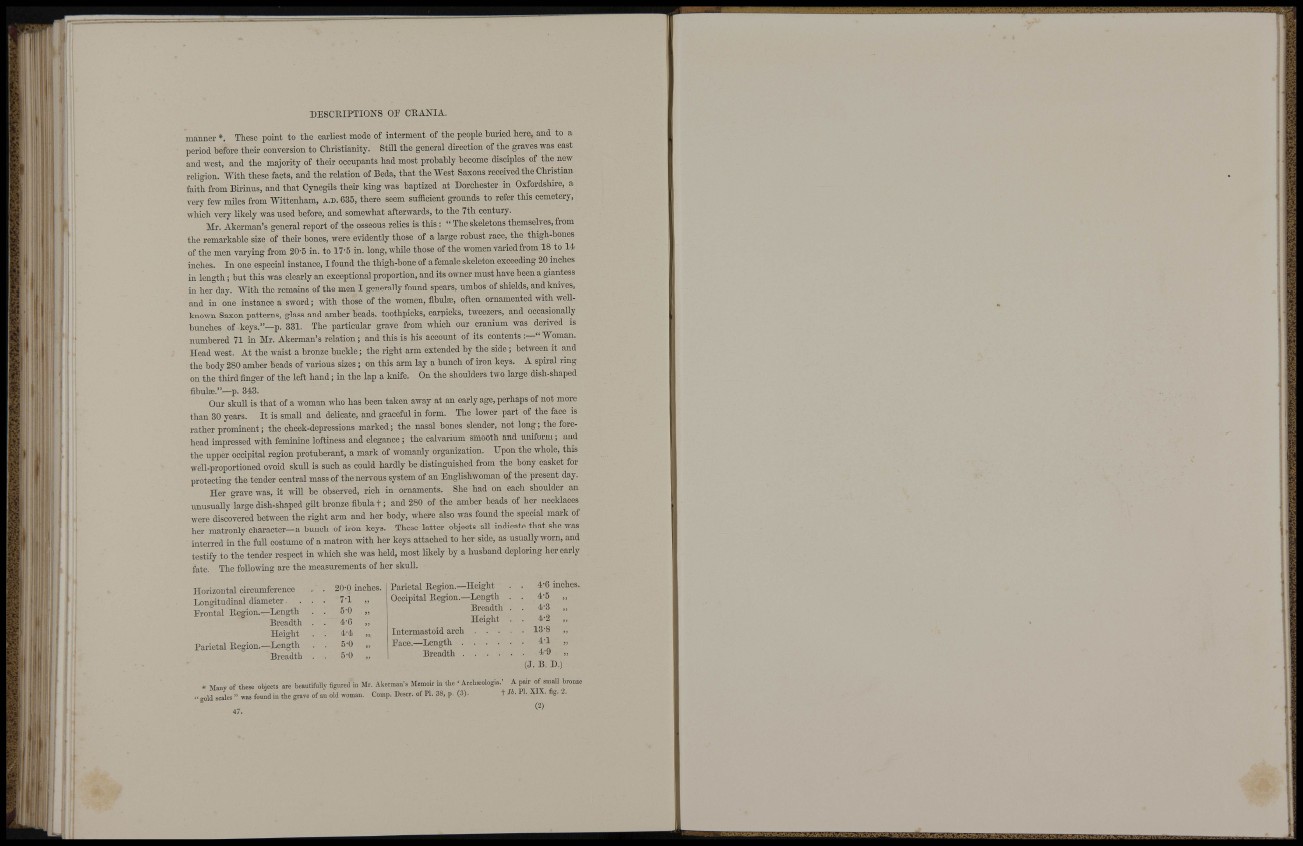
" n
111 " -
Ii:
il
i l|:
'I S
iM
• • I
; I , •
DESCRIPTIOKS OE CEANIA.
manner *. These point to the eai-liest mode of interment of the people buried here, and to a
period before their conversion to Christianity. Still the general direction of the graves was east
and Tvest, and the majority of their occupants had most probably become disciples of the new
religion. With these facts, and the relation of Beda, that the West Saxons received the Christian
faith from Bu-inus. and that CynegUs their king was baptized at Dorchester in Oxfordshire, a
very few miles from Wittenham. a.b. 635, there seem snfadent groxmds to refer this cemetery,
which very likely was used before, and somewhat afterwards, to the 7th century.
Mr. Akerman's general report of the osseous relics is this: " The skeletons themselves, from
the remai-kable size of their bones, were evidently those of a large robust race, the thigh-bones
of the men vai-ying from 20-5 in. to 17'5 in. long, while those of the women vai'ied from 18 to 14
inches. In one especial instance, I found the thigh-bone of a female skeleton exceeding 20 inches
in length; but this was clearly an exceptional proportion, and its owmer must have been a giantess
in he/day. With the remains of the men I generaUy found spears, umbos of shields, and knives,
and in one instance a sword; ^^ith those of the women, flbul®, often ornamented with wellknown
Saxon patterns, glass and amber beads, toothpicks, earpicks, tweezers, and occasionally
bunches of keys."—p. 331. The particular grave from which our cranium was derived is
numbered 71 in Mr. Akerman's relation; and this is his account of its contents "Woman.
Head west. At the waist a bronze buckle; the right arm extended by the side; between it and
the body 280 amber beads of various sizes ; on this arm lay a bimch of iron keys. A sph-al ring
on the thii-d finger of the left hand; in the lap a knife. On the shoulders two large dish-shaped
flbulffi."—p. 343.
Our skull is that of a woman who has been taken away at an early age, perhaps of not more
than 30 years. It is smaU and deUcate, and graceful in form. The lower part of the face is
rather prominent; the cheek-depressions marked; the nasal bones slender, not long; the forehead
impressed with feminine loftiness and elegance; the calvarium smooth and uniform; and
the upper occipital region protuberant, a mark of womanly organization. Upon the whole, this
well-proportioned ovoid skull is such as could hardly be distinguished from the bony casket for
protecting the tender central mass of the nervous system of an Englishwoman of the present day.
Her -rave was, it will be observed, rich in ornaments. She had on each shoulder an
imusuaUytoge dish-shaped gilt bronze fibula t ; and 280 of the amber beads of her necklaces
were discovered between the right arm and her body, where also was foimd the special mark of
her matronly character-a bimch Of iron keys. These latter objects all indicate that she was
interred in the full costume of a matron with her keys attached to her side, as usually worn, and
testify to the tender respect in which she was held, most likely by a husband deploring her early
fate. The following are the measurements of her skull.
4-6 inches.
. 4-5 „
. 4-3 „
. 4-2 „
. 13-8 „
. 4-1 „
. 4-9 „
(J. B. D.)
* Many of these objects are beautifully figured in Mr. Akerman's Memoir in the • Arch^ologia.' A Paii' of ™all bronze
" .old scales " was found in the grave of an old woman. Comp. Descr. of PI. 38, p. (3). t U- PI- XIX. fig. 2.
(2)
Horizontal circumference
Longitudinal diameter
Trontal Eegion.—Length
Breadth
Height
Parietal Region.—Length
Breadth
20-0 inches.
7-1 „
5-0 „
4-6 „
4-4 „
5-0 „
5-0 „
Parietal Region.—Height
Occipital Region.—Length
Breadth
Height
Intermastoid arch . . .
Face.—Length . . . .
Breadth . . . .
• I
• ifi I